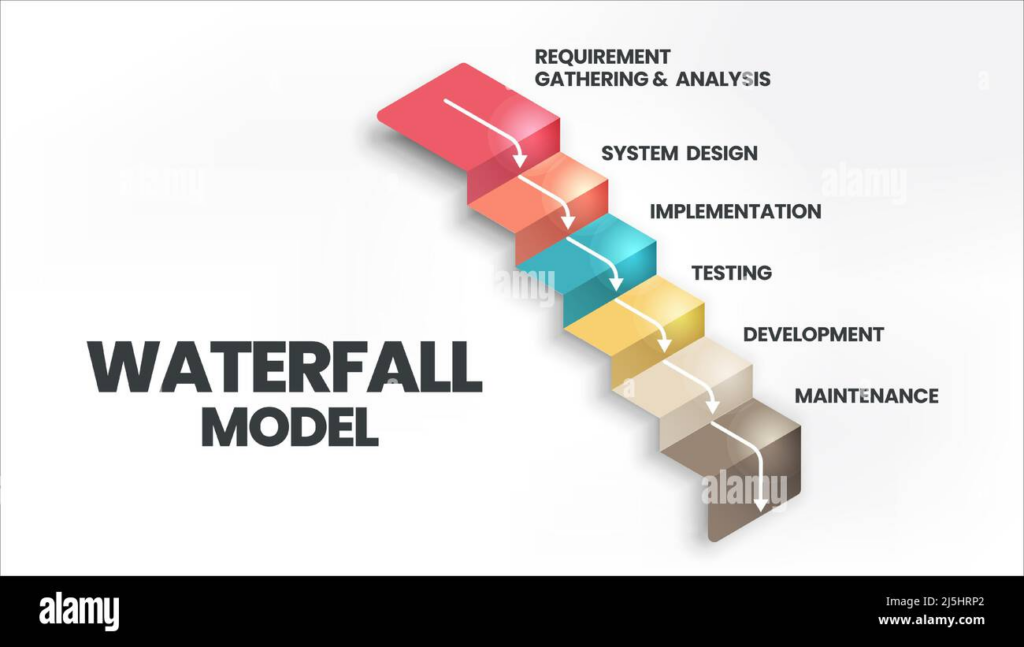Choosing the right development model for your project can be a daunting task. With diverse options like waterfall, agile, and iterative models to choose from, you might find yourself lost in technical jargon.
This blog aims to simplify these terms for you and guide you towards making an informed choice based on their distinctive features and benefits. Let’s dive into understanding what each of these models look like – no tech expertise necessary!
Key Takeaways
- The waterfall model is a traditional and linear approach to software development, while the agile and iterative models embrace flexibility and adaptability.
- The waterfall model follows a sequential approach with distinct phases that must be completed before moving on to the next, while the agile and iterative models encourage simultaneous work on different aspects of development.
- Pros of the waterfall model include structured planning and documentation, but it can be inflexible when accommodating changes. Agile models offer flexibility, collaboration, and quicker response times to changing requirements, but may face challenges in managing large-scale projects. The iterative model combines elements of both approaches for continuous improvement while providing structure to the project.
Waterfall Model
The waterfall model is a traditional development process characterized by sequential phases and a linear fashion of progression.

Definition and characteristics
The Waterfall Model, often dubbed the ‘traditional’ approach in software development, is a linear process. It begins with system requirements and design, succeeded by implementation, verification, and maintenance stages.
Each phase is distinct and must be completed before proceeding to the next one. This model emphasizes meticulous planning and documentation to ensure precise project outcomes.
The Agile Model takes an incremental and iterative approach to software development. It considerably expands on the idea of collaborative problem-solving among cross-functional teams.
Instead of waiting until all components are complete to test a product, testing occurs simultaneously with development in this model. The agile method welcomes changes even late into the life cycle for better customer satisfaction.
In contrast to both models above stands the Iterative Model. Rather than completing all stages for the entire system at once like waterfall or developing small increments as in agile, iterative breaks down overall software development into mini-waterfalls where phases repeat through iterations until you achieve a perfect version of your product.
Phases and sequential approach
The waterfall model follows a sequential approach with distinct phases. Each phase must be completed before moving on to the next. These phases typically include requirements gathering, system design, implementation, testing, deployment, and maintenance.
The linear fashion of this approach means that each phase builds upon the previous one and progress is measured at the end of each stage. While this method provides structure and clarity in terms of project goals and deliverables, it can also be inflexible when unexpected changes or updates are needed throughout development.
In contrast, agile and iterative models embrace a more flexible approach by dividing the project into smaller iterations or sprints. Instead of completing all phases sequentially like in waterfall, these models encourage simultaneous work on different aspects of software development.
Pros and cons
The waterfall model offers a structured and linear approach to development, making it easy to plan and document the entire process. It allows for clear requirements upfront, reducing the likelihood of unexpected changes later on.
However, this approach can be inflexible when it comes to accommodating changes or feedback during development. On the other hand, agile models like Scrum and Kanban promote flexibility by emphasizing iterative and incremental development.
They enable collaboration between team members and stakeholders, allowing for quicker response times to changing requirements. However, these models may face challenges in terms of managing large-scale projects or maintaining documentation throughout the process.
In contrast, an iterative model combines elements of both waterfall and agile methodologies, offering a cyclical approach that allows for periods of planning followed by development iterations.
Agile Model
The Agile Model is a development methodology characterized by an iterative and incremental approach to software development.

Definition and characteristics
The Waterfall model is a traditional software development approach that follows a linear fashion, where each phase is completed before moving on to the next. It involves clearly defined requirements and isolated phases, making it easier to manage and control.
However, it lacks flexibility when dealing with expected changes during the development process. On the other hand, Agile methodology is characterized by an iterative and incremental approach.
It focuses on regular feedback from stakeholders and encourages rapid and flexible responses to change throughout development. This allows for faster delivery of feature-rich software while ensuring customer satisfaction.
Iterative and incremental approach
The iterative and incremental approach is a development process that focuses on breaking down the project into smaller, manageable chunks. Instead of waiting until the end to deliver a fully functional product, this approach allows for continuous iterations and improvements throughout the development cycle.
Each iteration builds upon the previous one, adding new features or addressing feedback and changes from stakeholders. This method enhances flexibility, as it can quickly adapt to evolving requirements and customer needs.
It also allows for early testing and feedback, ensuring that any issues are identified and resolved earlier in the process.
Pros and cons
The waterfall model offers the advantage of a clear, linear approach with well-defined phases that make it easy to plan and schedule projects. However, its rigid structure can make it difficult to accommodate changes or unexpected challenges.
On the other hand, the agile model allows for flexibility and adaptation throughout the development process, enabling teams to respond effectively to changing requirements. However, this flexibility can also lead to scope creep or a lack of defined milestones.
As for iterative development, it allows for incremental progress and feedback from stakeholders at various stages, ensuring that each round of iteration builds on previous ones. Nevertheless, frequent iterations can increase project duration and may require more coordination between team members.
Iterative Model
The Iterative Model is a cyclical approach to software development, allowing for incremental development and flexibility in adapting to changing requirements. Find out more about its characteristics and pros and cons here!

Definition and characteristics
The Waterfall Model is a traditional software development process that follows a sequential approach. It consists of distinct and isolated phases, where each phase must be completed before moving on to the next.
The characteristics of the Waterfall model include clearly defined requirements at the beginning, limited flexibility for changes once the project has started, and an emphasis on upfront planning and documentation.
This model works well when there is a stable and predictable set of requirements, but it can be rigid in accommodating change requests during development.
Cyclical approach
The cyclical approach, also known as the iterative model, is a development process that involves repeating cycles of planning, designing, building, and testing. Unlike the traditional waterfall model which follows a linear fashion from one phase to another, the cyclical approach allows for flexibility and adaptability throughout the software development process.
In this approach, each cycle focuses on delivering small increments of functionality that can be tested and reviewed by stakeholders. This iterative nature allows for continuous feedback and collaboration, ensuring that any necessary changes or improvements can be incorporated into subsequent cycles.
By breaking down the project into smaller chunks and addressing them in an incremental manner, the cyclical approach promotes faster delivery of usable software with improved feature richness.
Although this approach offers several benefits such as increased flexibility and adaptability to changing requirements, it also has its drawbacks. For instance, there may be challenges in managing complex dependencies between different iterations or maintaining consistency across multiple cycles.
Pros and cons
There are several pros and cons to consider when it comes to the agile, iterative, and waterfall models of software development. One of the advantages of the agile model is its flexibility and ability to adapt quickly to changing requirements.
It also promotes collaboration among team members and allows for faster delivery of working software. On the other hand, one of the downsides is that it may be difficult to manage if there isn’t clear communication within the team.
In contrast, the waterfall model provides a structured approach with clearly defined phases, making it easier to manage projects. However, it can be inflexible when changes need to be made during development.
The iterative model combines aspects of both agile and waterfall by dividing development into cycles or iterations, allowing for incremental progress while still maintaining some level of structure.
Comparing Agile, Iterative, and Waterfall Models
Agile, Iterative, and Waterfall models differ in their approach to software development, with each having its own set of advantages and disadvantages. Understanding these differences is essential in choosing the right model for a particular project.
Key differences and similarities
The key differences and similarities between the Agile, Iterative, and Waterfall models lie in their approach to software development. The Waterfall model follows a sequential process with isolated phases, while both the Agile and Iterative models take an iterative approach.
However, the Agile model focuses on flexibility and collaboration through shorter iterations and continuous feedback, while the Iterative model emphasizes incremental development over multiple cycles.
All three models have their pros and cons depending on factors like feature richness, clearly defined requirements, expected changes, and team dynamics.
When to use each model
The choice of development model depends on various factors such as the project requirements, team capabilities, and time constraints. The waterfall model is suitable for projects with well-defined requirements and a fixed scope.
It works best when there is no need for frequent changes or iterations, making it ideal for projects with stable technologies and predictable outcomes.
On the other hand, the agile and iterative models are more flexible and adaptable to changing requirements. Agile is great when working in environments where collaboration between teams is essential.
It allows for continuous feedback, quick iterations, and focuses on delivering value to customers early on. Iterative models are beneficial when there is a need to develop complex systems incrementally while allowing room for modifications and improvements along the way.
Factors to consider in choosing the right model
Consideration must be given to several factors when choosing the right development model for a project. First, it’s important to assess the level of flexibility required. Agile models offer greater adaptability and allow for changes throughout the process, making them ideal for projects with evolving requirements.
On the other hand, waterfall models follow a more structured approach and are better suited for projects with well-defined and stable requirements. Another factor to consider is time management.
Iterative models emphasize incremental development and frequent iterations, while waterfall models focus on completing each phase before moving onto the next. Additionally, resource allocation should be taken into account, as agile models require highly collaborative teams that work closely together throughout the entire process, whereas in waterfall models individuals can have more clearly defined roles within isolated phases of development.
Conclusion
In conclusion, when choosing a development process for your project, it’s important to consider the specific requirements and constraints of your work. The waterfall model offers a linear and structured approach, which is suitable for projects with clearly defined requirements and low expected changes.
On the other hand, the agile model provides an iterative and incremental approach, allowing for flexibility and adaptability in response to evolving needs. The iterative model falls somewhere in between, offering a cyclical approach that combines features of both waterfall and agile methodologies.
Ultimately, selecting the right process depends on factors such as project complexity, team dynamics, stakeholder involvement, and desired speed of delivery.
Frequently Asked Questions
1. What is the difference between Agile, Iterative and Waterfall development processes?
Agile, Iterative and Waterfall are different types of development processes used in projects. Agile emphasizes team collaboration and customer feedback, while iterative focuses on componentization and repeated cycles of development. On the other hand, Waterfall follows a linear approach from start to finish with emphasis on documentation.
2. How does Lean compare to Spiral or RAD Rapid Application Development?
Lean prioritizes eliminating waste for efficiency whereas Spiral uses risk analysis for improvements at every cycle of iteration; RAD Rapid Application Development puts emphasis on fast prototyping and user feedback.
3. Can XP Extreme Programming be combined with other methods like PRINCE Projects in Controlled Environments?
Yes! XP Extreme Programming can work well with PRINCE Projects in Controlled Environments as both place high focus on quality standards through system checks, reviews or testing during all stages.
4. What is an Iterative waterfall process?
Iterative waterfall process combines aspects from both iterative model where iterations occur but once a phase is finished it never revisited (like waterfall). So it’s kind-a repeatable sequence within an unrepeatable sequence.



